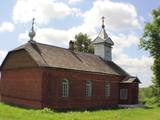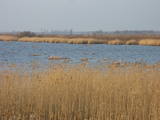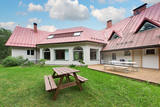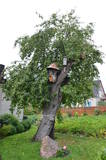| Nr | Nosaukums | Apraksts |
|---|---|---|
|
Vieta, kur 1. pasaules kara laikā 1916. g. notika t.s. Ziemassvētku kaujas starp Krievijas un Vācijas karaspēku, pēc kurām latviešu strēlnieku drosme un varonība aizskanēja tālu pāri valsts robežām. Ložmetējkalnā ir izveidota piemiņas vieta latviešu strēlniekiem un atjaunots skatu tornis. No tā labi redzams Maztīreļa purvs ar bijušo vācu šaursliežu dzelzceļa līnijas vietu, kas to šķērso ziemeļu - dienvidu virzienā, iezīmējot purvā lielāku koku rindu. Kā iepazīt? Iespēja doties pārgājienos gan ar gidu, gan bez, apmeklēt Ziemassvētku kauju muzeja "Mangaļu" māju, kuras apkaimē izveidots marķēts izziņas maršruts, piedalīties tematiski izglītojošos pasākumos un kauju imitācijās. Apskatāmi pieminekļi, karavīru kapi, ierakumi, fortifikācijas, zemnīcas u.c. Mangaļu mājās atrodas Latvijā lielākais kauju vietu makets. Apskatāmi Baltijas reģionam unikāli 1. pasaules kara lauka fortifikācijas elementi, kas saistīti ar leģendārajām Ziemassvētku kaujām: autentiskā vietā rekonstruēts nocietinājumu sistēmas posms – blindāža un daļa no vācu aizsardzības pirmās līnijas t.s. „Vācu valnis”. |
||
|
Dziedinošie Dārzi ir daļa no 125 ha lielās bioloģiskās saimniecības Upmaļi. Šeit jau ceturtajā paaudzē saimnieko Bergmaņu ģimene. Patreizējie saimnieki Māra un Dainis Bergmaņi, kopā ar ģimeni, cenšas saglabāt senās, vēl 30. gados stādītās retās augļu koku un krūmu šķirnes vecajā dārza daļā. Līdzās senajiem kokiem šeit izveidoti arī īpašu dziedinošo koku, retu augļu koku ( plūškoki, valrieksti, ēdamās kastaņas, zīdkoki, u.c) un ārstniecības augu dārzi vairāk kā 12 ha platībā. Saimnieku teju 30 gadus ilgā pieredze dabas dziedniecībā, arī Ajūrvēdas tradīcijās, ir ļāvusi izveidot oriģinālus AnnA Bergmans zīmola produktus- augu ziedes, balzāmus un krēmus, zāļu tējas, eļļas u.c. Aizraujošā un darbīgā ekskursijā skaistajos dārzos un Zāļu namā, kopā ar zāļu sievu Māru, ikvienam viesim ir iespēja gan atpūsties, gan, ļoti iespējams, izprast – kurš no Dabas brīnumiem var mani darīt veselāku un laimīgāku. |
||
|
Kihnu Island is the largest island in the Gulf of Rīga and the seventh largest island in Estonia. Its total area is 16.9 km², the island is 7 km long and up to 3.3 km wide. The former seal hunter and fishermen’s island, with around 600 inhabitants, is currently eager to maintain its identity in spite of everything. The unique characteristics of the Kihnu cultural space, like the lifestyle of the community, the diverse cultural traditions, the Kihnu language, music, national costumes and nature, are included in the UNESCO cultural heritage list. A coastal route that goes through four villages – Sääre, Linaküla, Rootsiküla and Lemsi - will help you to discover the cultural and natural values of Kihnu Island. You can visit Kihnu Museum all year round and get insight into the history of the island, including the life of the famous local captain, Kihnu Jõnn. It is also worth seeing Kihnu Church and the cemetery located across from the museum. In the summer, you can enjoy a beautiful view of the island, the surrounding sandbanks and the sea from the lighthouse. The commemorative stone by the former house of Kihnu Jõnn introduces you to the island’s legendary “wild captain”. |
||
|
Borisovas vecticībnieku kopienas lūgšanu nams uzcelts laika
posmā no 1911. līdz 1921. gadam. Atšķirībā no citiem lūgšanu
namiem apkaimē Borisovas dievnams ir veidots no ķieģeļiem un atrodas kalna pakājē. Zvans šim dievnamam speciāli tika pasūtīts Pēterburgā, un tas izceļas ar savu īpaši maigo skanējumu.
|
||
|
Apdzīvota vieta ~ 1 km dienvidos no Daugavpils – Krāslavas (A 6) ceļa, kas pazīstama ar savu neparasto nosaukumu. Interesanti, ka vietvārds saistīts arī ar iedzīvotāju uzvārdiem, ko var redzēt tāda paša nosaukuma kapos. Ciema apkaimē pazīstams ir Lielo Muļķu svētavots, kuru gan nezinātājam ir grūti atrast, tādēļ ieteicams izmantot vietējā gida pakalpojumus, apvienojot šīs vietas izziņu ar biškopības saimniecības „Cīruļi” apskati. |
||
|
Sakoptajos un ainaviskajos saimniecības laukos zied lilijas, peonijas un dienziedes. Izveidots skaists akmeņdārzs un top dendroloģiskais parks. > 100 bišu saimes ievāc medu. Saimniece vada ekskursijas, piedāvā stādu un medus produkcijas iegādi. |
||
|
Burvja virtuvē piedāvā garšīgus ēdienus no apkārtnē izaudzētajām izejvielām. Noteikti jānomēģina nātru zupa, kas atzīta par labāko Dienvidigaunijas zupu. Nõiariik ir piemērota aktīvai atpūtai gan ģimenēm, gan lielākām kompānijām. |
||
|
Klūgu ģimenes ainavu dārzu, kas ir atzīts par vienu no skaistākajiem dārziem Latvijā, ir noteikti jāieplāno vasaras ceļojumu listē. Vislabāk izbaudīt dārza daudzveidīgo ainavu paši saimnieki iesaka jūlija mēnesī, kad viskrāšņāk sazied dažādās vasaras puķes. Saimnieces Ženijas mīļākie ziedi ir begonijas, kuras dārzā ir sastopamas gan puķu dobēs, gan sastādītas īpašos puķu podos. Lai klātienē piedzīvotu Klūgu ģimenes sapni – dzīvot parkā, ir jāredz Latvijas ainavai raksturīgo lielo lapu koku, dažādo skujkoku un krāšņumkrūmu parku, kas ir tapis vairāku gadu garumā, pašu saimnieku – Ženijas un Aivara roku darbs un lepnums. |
||
|
Sekls, eitroficēts lagūnas tipa (senā Litorīnas jūras lagūna) ezers, kura aizaugums ir sasniedzis ~ 60 %. Dabas liegums veidots gan aizaugošā ezera, gan tās apkārtnes (mitras pļavas) biotopu un ligzdojošo putnu (ap 60 sugas) aizsardzībai. Ezera apskates nolūkos var izmantot dambju sistēmu tā dienvidu krastā. Populāra makšķerēšanas un putnu vērošanas vieta.
|
||
|
Atpūtas centrā tiek piedāvāta iespēja atpūsties brīvā dabā kolektīviem vai individuāliem apmeklētājiem. Iespējams izmēģināt dažādus metamos ieročus (nažus, cirvjus u.c.), kā arī šaušanu ar dažāda veida lokiem, arbaletiem, pneimatiku u.c. |
||
|
Konferenču un atpūtas centrs “Zvīguļi” atrodas Gaujas nacionālā parka teritorijā – ar gleznainu un neskartu dabu no vienas puses un Siguldas šoseju (A2) no otras puses. No iekšpagalma paveras meža ieloks, no kura, ejot pa reljefainu, dabas veidotu un sakoptu taciņu, klausoties Skolas upītes čalās, nonāksi 15 minūtēs Gaujas upes krastā. No ārpagalma ar savu vai sabiedrisko transportu ātri un ērti nonāksi sev vēlamajā vietā. Līdz Siguldai vien 8 minūtes jeb 10 km. Piedāvā naktsmītnes dažāda komforta istabiņās vai koptelpā. Ir plaša un moderni aprīkota virtuve. Viesu namā ir arī četrvietīga somu pirts. Nepieciešamības gadījumā ēdināšanu nodrošinās mūsu sadarbības partneri. Aktīvās atpūtas iespējas netālu – rodeļu trase, velosipēdu īre, makšķerēšana, laivošana, kvadraciklu un motociklu trase, zirgu izjādes. |
||
|
„Joži” meklējami Jaunpilī, Jaunpils – Viesatas ceļa malā. „Joži” ir viena no lielākajām Latvijas graudkopības (ziemāji, vasarāji un arī rapši) saimniecībām, kas sākusi veidoties pagājušā gadsimta astoņdesmito – deviņdesmito gadu mijā. Šobrīd saimniecībā slejas 14 graudu torņi, tiek rekonstruēta graudu kalte. Kopumā tiek apsaimniekoti ap 5000 ha zemes, izveidots moderns lauksaimniecības tehnikas parks. Saimnieki Gunvaldis un Guna Sproģi aktīvi iesaistās dažādu ES projektu īstenošanā. Dažādu konkursu (t.sk. „Sējējs”) uzvarētāji un laureāti. |
||
|
Trīs krāteri, no kuriem lielākā – Elles kapa (Põrguhaud) diametrs ir ~ 80 m, dziļums līdz 12 m. To ietver vairākus metrus augsti vaļņi. Pārējie krāteri ir dabā grūti atrodami un atpazīstami. Krāteru vecums ir ~ 6000 gadi. Līdz šim gan nav atrastas meteorīta atliekas, kas apstiprinātu to izcelsmi.
|
||
|
Dažāda lieluma grupām piedāvā došanos jūrā ar zvejnieku laivu un piekrastes zvejas gaitas vērošanu. Uz Svētupes taisītais nēģu tacis atšķiras no Salacas tačiem pēc uzbūves un zvejas principiem. Sezonas laikā kūpina un gatavo gardus nēģus. |
||
|
Mierīga vieta dabas tuvumā, kur lieliski atpūsties. Ēdiens gatavots no Hiiumaa apkārtnē pieejamām izejvielām atbilstoši viesu vēlmēm. Papildus var baudīt autentisku malkas apkures saunu un peldi mucā, bērniem iekārtots rotaļu laukums. |
||
|
Uzņēmums Ineses Tortes ir vienīgais Latvijas ražotājs, kas ražo tortes un desertus, kas izgatavoti no 100% dabīgām un vietējās izcelsmes sastāvdaļām. Konditoreja, kuru 1993. gadā dibināja izcilā konditormeistare Inese Goldmane, sāka darboties kā neliels ģimenes uzņēmums Kuldīgā. Šobrīd katru mēnesi ražojam tūkstošiem tortes un desertus, kas nonāk uz pircēju galdiem gandrīz visā Latvijā. Aicinām ciemos ikvienu, kas vēlas baudīt tasi kafijas un tējas kopā ar gardu tortes gabaliņu, kā arī uzzināt par mums un mūsu produkciju! |
||
|
Kafejnīca "Pie Jančuka" atrodas Līgatnes kultūras nama ēkas pagrabstāvā. Vasarās pie Līgatnes upītes izveidota vasaras terase. Latviešu virtuve: Siļķe, aukstā zupa, kupāti, cūkgaļas kotletes, mednieku desiņas, cūkgaļas ribiņas, pankūkas ar biezpienu, kartupeļu pankūkas. Īpašais ēdiens: Cūkgaļas karbonāde „Pie Jančuka”. |
||
|
Senākā Lietuvas ābele – augļkoks, kas ir botāniskais mantojuma objekts. Koka šķirne – mežābele. Tā ir vienīgā apsargājamā ābele Lietuvā. |
||
|
No Kronvaldu Ata (1837. – 1875.) – izcilā latviešu publicista, pedagoga un valodnieka dzimtajām mājām – „Lejas Miķiem” Priekules novada Krotē nekas līdz mūsdienām vairs nav saglabājies. Māju vietā uzstādīta piemiņas plāksne ar uzrakstu: „Katram tā vieta svēta, kur piedzimis, audzis” (A. Kronvalds). |
||





























